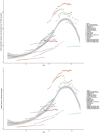Analysis of the burden of colorectal cancer attributable to high body mass index in 204 countries and regions worldwide from 1990 to 2021
- PMID: 40551739
- PMCID: PMC12183065
- DOI: 10.3389/fnut.2025.1589250
Analysis of the burden of colorectal cancer attributable to high body mass index in 204 countries and regions worldwide from 1990 to 2021
Abstract
Background: Colorectal cancer (CRC) is the second most common malignancy and the third leading cause of cancer-related deaths globally. Numerous studies have established a link between high body mass index (BMI) and CRC. However, a detailed analysis of the global disease burden of CRC attributable to high BMI has been lacking.
Objective: This study aimed to evaluate the spatiotemporal trends in mortality and disability-adjusted life years (DALYs) attributable to high BMI-related CRC at global, regional, and national levels from 1990 to 2021.
Methods: Epidemiological data on the association between high BMI and CRC were extracted from the 2021 Global Burden of Disease (GBD) study. Data on mortality, DALYs, age-standardized mortality rate (ASMR), and age-standardized DALY rate (ASDR) were stratified by sex, year, age, country, and Socio-demographic Index (SDI). Estimated annual percentage changes (EAPC) were calculated to assess temporal trends in ASMR and ASDR attributable to high BMI from 1990 to 2021. Decomposition and frontier analyses were conducted to identify drivers of burden changes and top-performing countries. Inequality analysis was performed to assess burden disparities across different SDI levels. The Bayesian age-period-cohort (BAPC) model was used to predict disease burden up to 2050.
Results: Deaths and DALYs related to high BMI-associated CRC showed a robust upward trend, more than doubling in absolute numbers since 1990. Without intervention, similar patterns are projected to continue over the next 29 years. East Asia exhibited the highest risk of CRC deaths and DALYs attributable to high BMI, with the heaviest burden observed in China and the United States. High SDI regions demonstrated a higher burden, while low SDI regions faced higher EAPC.
Conclusion: This study highlights high BMI as a significant risk factor for CRC, with notable regional heterogeneity in disease burden. Stratification by SDI and health inequality analysis underscore the need for tailored preventive strategies and health interventions targeting high BMI, particularly in different SDI regions.
Keywords: Global Burden of Disease; colorectal cancer; health inequality; high body mass index; socio-demographic Index.
Copyright © 2025 Zhao, Zheng and Chen.
Conflict of interest statement
The authors declare that the research was conducted in the absence of any commercial or financial relationships that could be construed as a potential conflict of interest.
Figures









References
LinkOut - more resources
Full Text Sources

